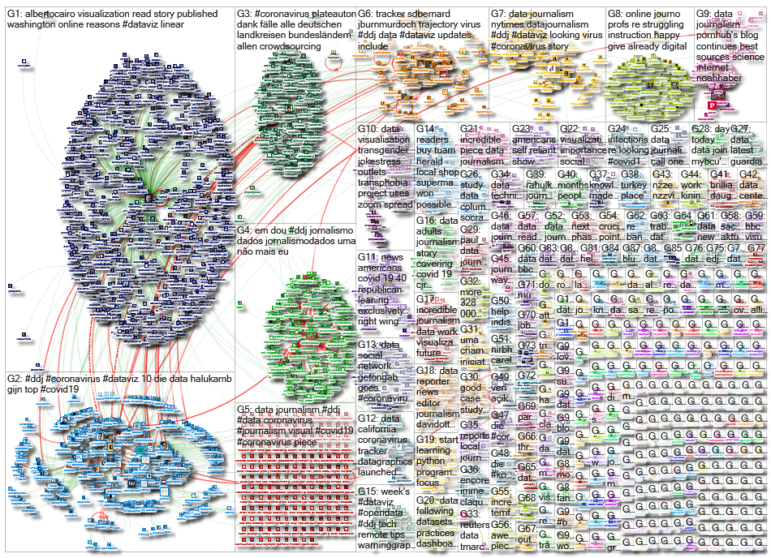The attention of the global data journalism community remains very much tuned in to the developing COVID-19 pandemic, which is reflected in our NodeXL #ddj mapping from March 16 to 22. The New York Times mapped the movements of millions of people to trace how the virus spread from China, The Financial Times tracked how coronavirus case trajectories compare among countries, while Robert Kosara explains the brilliance of a “Flatten the Curve” cartoon. We also found a wonderful respite from COVID-19 with data visualization designer Federica Fragapane’s project analyzing the dreams of people around the world.
How the Virus Got Out
Even with major border lockdowns, travel restrictions, and extensive reduction of flights, the world has been unable to halt the widespread outbreak of the novel coronavirus. The New York Times explores why these restraints haven’t been enough by mapping the movements of hundreds of millions of people.
A stunning, exhaustively-sourced and gorgeously illustrated picture story of how the virus got out of Wuhan and into every corner of the world long before the travel restrictions were put in place https://t.co/kGH8N8U8i2
— Apoorva Mandavilli (@apoorva_nyc) March 22, 2020
Coronavirus Death and Case Tracker
The Financial Times is tracking the trajectories of coronavirus-related deaths and cases worldwide, putting them in the same chart to show how countries compare with one another. It offers a worrying look at which countries have outbreaks on the same trajectory as Italy, the hardest hit nation in Europe so far. The previously pay-walled article is now free-to-read.
You asked, we answered:
The @FinancialTimes coronavirus death & case trajectory trackers are now 🔥 FREE TO READ 🔥 outside the paywall: https://t.co/JxVd2cG7KI
In this morning’s update, the US has gone above 470 deaths, bringing it just behind where Iran was at the same stage. pic.twitter.com/NBA7FMYlmC
— John Burn-Murdoch (@jburnmurdoch) March 23, 2020
Why “Flattening the Curve” Went Viral
Robert Kosara, senior research scientist at Tableau Software, breaks down why the widely-circulated “Flatten the Curve” cartoon by epidemiologist Dr. Siouxsie Wiles and illustrator Toby Morris is such a succinct piece of visual communication.
Very powerful visual communication . @eagereyes is telling the evolution from an academic paper to even a cartoon explaining the idea of #FlattenTheCurve #Data #Dataviz #COVID19 https://t.co/WSjnGRFg24
— GISinJOUR (mkf) (@gisinjour) March 17, 2020
Linear or Non-linear Scales?
Do readers understand non-linear scales? And should data journalists avoid them? Alberto Cairo, Knight Chair in Visual Journalism at the University of Miami, explores this topic of using linear versus non-linear scales in his blog, and offers an example from Spain’s El País newspaper of how newsrooms can provide both views.
New post: Linear or non-linear scales? Why not both? https://t.co/aCpHBBar6l with a project by @elpais_info #dataviz #infographics #ddj pic.twitter.com/9qRfj2u3je
— Alberto Cairo (@AlbertoCairo) March 17, 2020
How COVID-19 Spread Across the Globe
Der Tagesspiegel visualized how COVID-19 spread across the globe in a time-lapse graphic. It also analyzed the speed at which the virus spread, and offered a glimpse at how badly the outbreak strains the population in each country by showing the number of infected per capita in affected countries. Hendrik Lehmann, head of Der Tagesspiegel’s innovation lab, also suggests some excellent coronavirus explainers here.
So hat sich das #Coronavirus nach und nach auf dem Globus verbreitet. Ab jetzt immer aktuell und als Zeitraffer auf unserer interaktiven Karte. 👇 #dataviz #ddj #maps #SARSCoV2 @Tagesspiegel https://t.co/Mqn1afskAk pic.twitter.com/nSTQoOq7R4
— Hendrik Lehmann (@plateauton) March 18, 2020
Tracking COVID-19 in L.A.
The Los Angeles Times offers a comprehensive look at the coronavirus outbreak situation in Los Angeles, including the trends over time, deaths, accounting of tests, mode of transmission, and more, using plenty of charts and maps.
More than 30 mill Californian lives have changed drastically, including >10 counties who have directed residents to shelter in place, the most restrictive measures in the U.S.
What is closed or restricted in your county? @priyakkumar & I are tracking: https://t.co/M0zndDrZbW pic.twitter.com/PxR91X9H4S
— Sandhya Kambhampati (@sandhya__k) March 18, 2020
The Shape of Dreams
Data visualization designer Federica Fragapane created a beautiful dream explorer based on Google Trends search data. She analyzed the different types of dreams across the globe, the search frequency for their meanings, the possible connections among languages that shared the same dream subjects, as well as unique dream subjects according to language. For example, there were searches for camel dreams in Arabic and iguana dreams in Spanish. She explains the process of making this project here.
The Shape of Dreams, my project for @GoogleTrends – mobile version ☁️https://t.co/qiYdRQVPN2
Development @paolocorti_ #dataviz #datavisualization #infographic #ddj pic.twitter.com/a80XnyaRvi— Federica Fragapane (@fedfragapane) March 19, 2020
Data Science for Journalists
Jonathan Soma, who runs the Lede Program, put together a site offering practical data science concepts and tools for journalists to learn and apply to investigations. It has practical guides, real-life story examples, and reference materials.
I think @dangerscarf might have assembled the most comprehensive list of data science techniques used in recent journalism projects – and he's written extensive Python tutorials to learn those techniques yourself! https://t.co/8EEULzTYDz pic.twitter.com/AKWFveIhqw
— Dan Nguyen (@dancow) February 19, 2020
Visualize Responsibly
At a time when the world is inundated by coronavirus news and COVID-19 charts, data visualization designer Amanda Makulec wrote a cautionary piece advising everyone to #vizresponsibly and to consider ten key points before making another chart about the pandemic.
1. Plenty of experts are making informative graphs you can look at.
2. If you do make your own please don't post them on social media.
3. Have a read of thishttps://t.co/CNBOgX4LPC
— Lee Constable 🔥 (@Constababble) March 17, 2020
Transphobia Tracking
Transgender rights activist Andrea James is building an interactive data visualization platform mapping people and media outlets that publish biased content about gender identity and expression. It will examine articles covering the topic in English and assign them a bias score.
The interactive chart will map journalists and publications that contribute to transphobia, assigning them a bias score and showing relationships between authors and publishers https://t.co/BRVATMnTde
— Journalism.co.uk (@journalismnews) March 20, 2020
Thanks again to Marc Smith of Connected Action for gathering the links and graphing them. The Top Ten #ddj list is curated weekly.
 Eunice Au is GIJN’s program coordinator. Previously, she was a Malaysia correspondent for Singapore’s The Straits Times, and a journalist at the New Straits Times. She has also written for The Sun, Malaysian Today, and Madam Chair.
Eunice Au is GIJN’s program coordinator. Previously, she was a Malaysia correspondent for Singapore’s The Straits Times, and a journalist at the New Straits Times. She has also written for The Sun, Malaysian Today, and Madam Chair.
For a look at NodeXL’s mapping on #ddj and data journalism on Twitter, check out this map.

